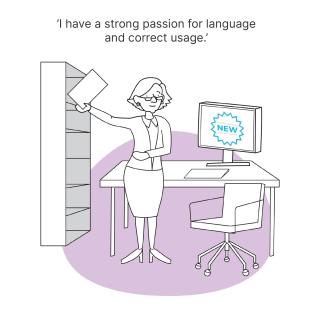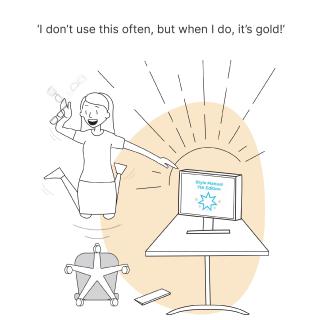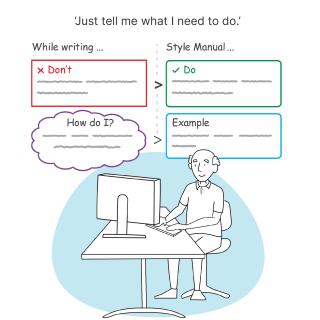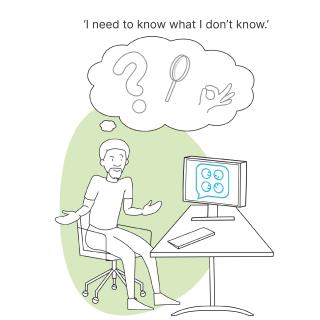The Style Manual has 4 main user types. We think about these users when we write and update content.
Before we started working on the current edition of the Style Manual, it was important to understand why and how people would use it. We also wanted to learn about the people who don’t use the Style Manual and how they behave when they discover it.
By researching our users, we found out what they wanted, and needed, from the new edition. We kept these needs in mind when we worked on the new manual. We keep them front of mind as we expand the Style Manual from a minimum viable product (MVP) to a mature digital service.
User research
It’s worth taking the time to do user research. If we want to meet our users’ needs, we have to understand their needs, behaviour and motivations. Our findings also help us to make good decisions that ensure the manual remains useful and relevant. User research is so important to the development of successful products and services that it’s a requirement of the Digital Service Standard.
During the Style Manual project, we worked with a user researcher to interview people from 18 agencies (Australian Government, state government and the private sector). The interviewees included editors, communications and social media officers, content developers, and policy and report writers.
During the interviews, we discovered how people used the 2002 Style Manual and how a new version could help meet their needs. We also learned that our users shared certain characteristics, allowing us to group them in ‘user types’.
Style Manual users
Our research identified 4 main user types:
- language pro
- all-round wordsmith
- rule seeker
- newcomer.
Identifying these user types helped us with the whole project. We learnt what each group wanted. The results of the research showed us how to proceed with the project. We then knew how to structure our content to meet the needs of these 4 user types.
Let’s go through each of these in more detail – you might even recognise yourself or someone you know.
Language pro
For this user type, picture a professional editor working in an organisation or as a freelancer. They edit corporate publications, annual reports or high-profile public content like the final reports by Royal Commissions. They might edit technical climate documents or workforce data reports. Writing and editing is their main job, so they know a lot about style.
Their colleagues and clients see language pros as gurus in their field. They often ask them questions about style and rely on their advice. Language pros use the Style Manual as an ally – a backup to help them in their quest to improve writing. Language pros sometimes provide the Style Manual with feedback on guidance if it is unclear. They have strong opinions on the quality of the guidance and about who is considered an expert in the writing and editing profession.
Language pros told us they need:
- a way to provide feedback and contribute to discussion about changes
- a way to bookmark commonly used (but easily forgotten) conventions
- a comprehensive resource for curly questions when people come to them for advice
- to be notified (proactively) of updates
- definitive answers, examples and context for why the rule is the rule
- an online manual (for search)
- a hardcopy manual (because they just love a hardcopy).
All-round wordsmith
All-round wordsmiths are often communication professionals working on various writing and editing tasks. Their working day might include editing a regulatory document, writing a punchy social media post or crafting an internal newsletter story.
The Style Manual is their safety net – a resource to check style rules quickly when they need to. If there is a tricky style question, or if they are editing dense content and technical jargon, the Style Manual can help.
All-round wordsmiths work with highly educated original authors. They already know most of the commonly used style conventions. They are not language pros, but they are good writers and people go to them to ask for help. They want to be sure they’re giving the right advice. All-round wordsmiths usually check their departmental style guide first and will only use the Style Manual if the department’s guide doesn’t contain the answer.
All-round wordsmiths told us they need:
- a comprehensive resource for when people come to them for advice
- content to help educate others
- ways to discover things they don’t already know
- the ability to ask questions
- to be notified of updates to relevant topics
- definitive answers and lots of examples to avoid arguments (no grey areas)
- bookmarks for commonly used (but easily forgotten) conventions
- an online manual (for search)
- a hardcopy manual, or the ability to print one (but just as a ‘nice to have’).
Rule seeker
Rule seekers write as part of their role but don’t have a professional background in writing and editing. They might write reports and policies or work in corporate services like human resources, finance or IT. Style is important to them, but they haven’t necessarily memorised the rules.
Rule seekers want to follow the correct style for public-facing content (for example, the agency website) to ensure that their agency is regarded as professional. They rely on the Style Manual (and their agency’s in-house style guide) to tell them how to apply style to projects and documents. They also use style rules because they care about consistency.
Where a rule comes from doesn’t interest rule seekers. They don’t use the Style Manual to learn how to write and edit – it is simply a tool to use as they work. How often rule seekers use the Style Manual depends on whether it’s needed for their current project. But when rule seekers do need the manual, they use it a lot.
Rule seekers told us they need:
- a comprehensive, all-in-one resource with powerful search capability
- the ability to bookmark commonly used sections or rules
- clear rules and examples using plain language
- streamlined and easy-to-use content that answers their questions
- definitive answers and examples
- an online manual only.
Newcomer
Everyone starts as a newcomer. Newcomers could be graduates, new to the Australian Public Service, or new to a writing and editing role. They’ve been introduced to the Style Manual at some stage – at school, university or when they started a new job. They are thrilled that there’s a resource like the Style Manual and want to read it all the way through to learn more.
Newcomers intend to use the Style Manual in their work, so they want to know the rules and where to find them. They might use the manual like a textbook and work through it in sections. Newcomers are keen to understand the process of writing, editing and publishing content.
Newcomers told us they need:
- a textbook-style resource that tells them what they need to know
- rules and conventions
- to know why style rules exist – it helps them to understand and remember
- the ability to ask questions
- the ability to bookmark relevant sections and rules
- powerful search with ‘fuzzy logic’ to help find answers based on the terms they enter
- an online manual (but they like how a book shows all the things you need to know in one place).
Newcomers will usually transition to a different user type over time. They might become an all-round wordsmith or rule seeker once they learn the basics.
Delivering what users need
As you can see, the 4 user types have both similar and different needs. We looked at all these user needs and prioritised the ones that were most important to users, and those that we could deliver. We couldn’t meet some technical needs, like a powerful search, but we’ve been able to deliver a lot of what our users said they needed.
User needs continue to inform our ongoing work to move the manual from an MVP to a more complete manual.
We think about you, and our user types, all the time. We aim to meet your needs when we:
- research and write new content
- review and update pages
- add new features to the website.
We’re a small team, so it does take time.
Your user type
You may recognise yourself as a particular user type, or as a couple of types combined. Perhaps something on the list of needs strikes a chord. Or you might want to have some fun and describe your user type with another name – ‘confident scribe’, ‘word nerd’, ‘style guru’ or ‘apprentice writer’?
The Style Manual team spent some time in quiet reflection and identified our own user types:
- Leanne is a language pro.
- Susan is a rule seeker.
- Shannon (me) is an all-round wordsmith.





